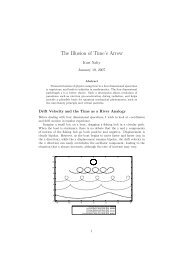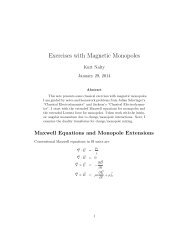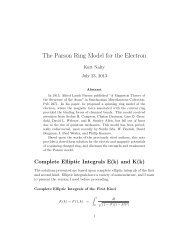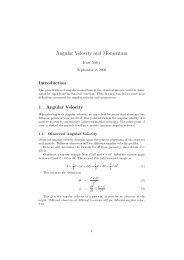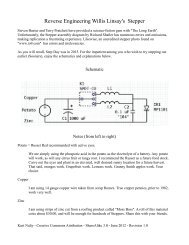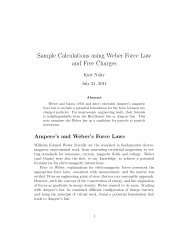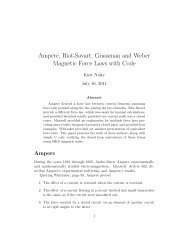Classical Calculation for Mutual Inductance of Two ... - Kurt Nalty
Classical Calculation for Mutual Inductance of Two ... - Kurt Nalty
Classical Calculation for Mutual Inductance of Two ... - Kurt Nalty
Create successful ePaper yourself
Turn your PDF publications into a flip-book with our unique Google optimized e-Paper software.
The positions and separations are<br />
r left = L cos φa x + L sin φa y − l 2 a z<br />
r right = R cos θa x + R sin θa y + l 2 a z<br />
∆r = (L cos φ − R cos θ) a x + (L sin φ − R sin θ) a y − la z<br />
r 2 = L 2 + R 2 + l 2 − 2LR (cos φ cos θ + sin φ sin θ)<br />
= L 2 + R 2 + l 2 − 2LR cos (φ − θ)<br />
r = √ L 2 + R 2 + l 2 − 2LR cos (φ − θ)<br />
We now can write our expression <strong>for</strong> the mutual inductance.<br />
∮ ∮<br />
dt · ds<br />
M = µ<br />
= µ ∮ ∮<br />
dt · ds<br />
s t 4πr 4π s t r<br />
= µ ∮ ∮<br />
4π<br />
= µ<br />
4π<br />
= µ<br />
4π<br />
∮<br />
φ<br />
θ<br />
( ∮<br />
φ θ<br />
∮<br />
φ<br />
( ∮<br />
θ<br />
LR (cos (φ − θ)) dφdθ<br />
√<br />
L2 + R 2 + l 2 − 2LR cos (φ − θ)<br />
)<br />
LR (cos (φ − θ)) dθ<br />
√ dφ<br />
L2 + R 2 + l 2 − 2LR cos (φ − θ)<br />
)<br />
LR (cos (θ − φ)) dθ<br />
√ dφ<br />
L2 + R 2 + l 2 − 2LR cos (θ − φ)<br />
where the last step uses the even nature <strong>of</strong> the cosine to absorb a minus sign.<br />
During the inner integration over θ, φ is kept constant. We now do a change<br />
<strong>of</strong> variable,<br />
γ = θ − φ<br />
dγ = dθ inside the θ integral<br />
We can simplify the mutual inductance expression.<br />
M = µ ∮ ( ∮<br />
4π φ γ<br />
= µ ∮<br />
4π<br />
= µ ∮<br />
2<br />
γ<br />
φ<br />
( ∮<br />
dφ<br />
γ<br />
LR cos γdγ<br />
√<br />
L2 + R 2 + l 2 − 2LR cos γ<br />
)<br />
dφ<br />
)<br />
LR cos γdγ<br />
√<br />
L2 + R 2 + l 2 − 2LR cos γ<br />
LR cos γdγ<br />
√<br />
L2 + R 2 + l 2 − 2LR cos γ<br />
This integral is known in terms <strong>of</strong> the complete elliptic functions K and E.<br />
The reference integral is<br />
∮<br />
cos θdθ<br />
√ = 4√ )<br />
]<br />
a + b<br />
[(1 − β2<br />
K(β) − E(β)<br />
a − b cos θ b<br />
2<br />
√<br />
2b<br />
where β =<br />
a + b<br />
3




